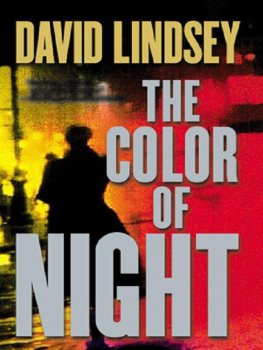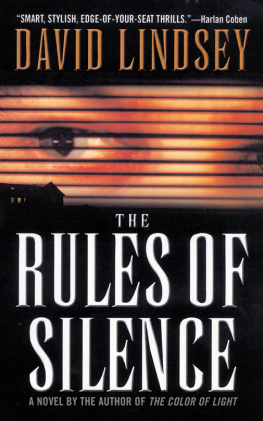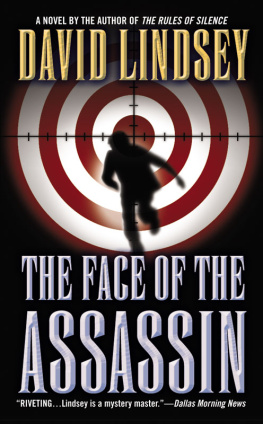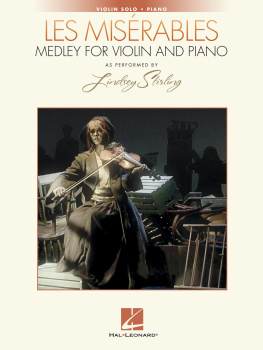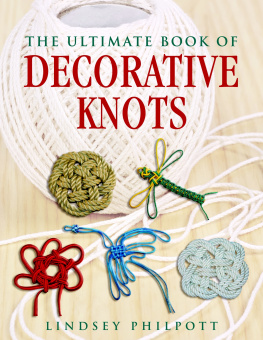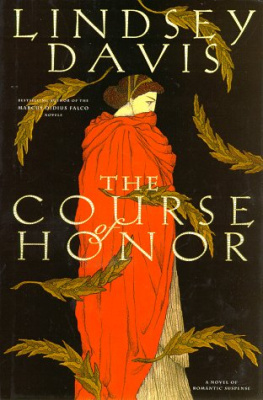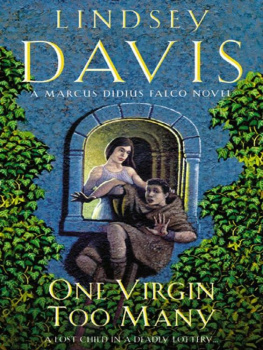David Lindsey - The Color of Night
Here you can read online David Lindsey - The Color of Night full text of the book (entire story) in english for free. Download pdf and epub, get meaning, cover and reviews about this ebook. genre: Detective and thriller. Description of the work, (preface) as well as reviews are available. Best literature library LitArk.com created for fans of good reading and offers a wide selection of genres:
Romance novel
Science fiction
Adventure
Detective
Science
History
Home and family
Prose
Art
Politics
Computer
Non-fiction
Religion
Business
Children
Humor
Choose a favorite category and find really read worthwhile books. Enjoy immersion in the world of imagination, feel the emotions of the characters or learn something new for yourself, make an fascinating discovery.
- Book:The Color of Night
- Author:
- Genre:
- Rating:3 / 5
- Favourites:Add to favourites
- Your mark:
- 60
- 1
- 2
- 3
- 4
- 5
The Color of Night: summary, description and annotation
We offer to read an annotation, description, summary or preface (depends on what the author of the book "The Color of Night" wrote himself). If you haven't found the necessary information about the book — write in the comments, we will try to find it.
The Color of Night — read online for free the complete book (whole text) full work
Below is the text of the book, divided by pages. System saving the place of the last page read, allows you to conveniently read the book "The Color of Night" online for free, without having to search again every time where you left off. Put a bookmark, and you can go to the page where you finished reading at any time.
Font size:
Interval:
Bookmark:
David Lindsey
The Color of Night
We are, I know not how, double within ourselves, with the result that we do not believe what we believe, and we cannot rid ourselves of what we condemn.
Michel de Montaigne, Essays (II, 16, 469 C)CHAPTER 1
VENICE, SESTIERE DI DORSODURO
It was the middle of the afternoon, and the windows of the old palazzo were partially opened to the crisp spring air. The study, filled with books and artwork obsessively arranged and cataloged and situated, overlooked the narrow canal, and the light that the room received was reflected off the buildings opposite, their weathered colors throwing off pale hues of apricot and lilac, wan ocher and coral and vanilla.
The sounds of the canal rose up on the summer heat and drifted into the room as well, carrying the voices of tourists strolling on the small fondamenta, the slosh of a passing gondola, the voices of merchants unloading produce from a small barge, water lapping under the bridge just beyond the window, a womans laughter.
Just put them here, the German said to the dealer, spreading his arms out over the long refectory table at which he sat and that he used as a working desk. He had moved aside orderly piles of paperwork and books to provide a clean surface.
The dealer nodded deferentially and approached the table with an oversize leather portfolio. His name was Claude Corsier, and he was a private art dealer from Geneva. He specialized in the drawings of artists of the nineteenth and twentieth centuries, the secondary market. That is, deceased artists. His unusual ceremonious manner was not a demonstration of particular respect for the German client. Corsier was known for his courtesy to everyone, billionaire and housemaid alike. It was said that his manner was a reflection of his lifelong respect for the artwork in which he traded.
Corsier put his portfolio on a small, marble-topped side table a step or two from his client and opened it. He was a large man, with big hands that one normally associated with farmworkers and laborers. But Corsiers hands were pale and soft, his nails manicured; they had never been darkened by the sun or stained by soil or lifted anything heavier than a folio reference book. His burly physique was genetic, not occupational. He had been bookish since childhood.
Each drawing was enclosed in its own acid-free paper folder to protect it. After opening the first folder, Corsier turned it around and placed it on the table before the German.
First, the Italians you wanted to see. Giovanni Boldini. Becoming very difficult to find these days. Six images here, and a small, quick sketch of a hand on the back of the sheet. These are studies for portraits, it seems, but the finished work, if it was ever completed, has never been identified. Leaning over the refectory table, he gently pointed to an image with the barrel end of a marbled fountain pen. The pen was less intrusive than using ones finger. The turned head is quite good here, he said.
The German, whose name was Wolfram Schrade, nodded, bending over the sketch to look at it closely. He picked up a horn-handled magnifying glass from the table and examined each image on the sheet of paper. There were six.
These are very nice, Schrade said. His accent was heavy, but attractive, sophisticated.
I like them, Corsier agreed modestly.
The German picked up the paper and looked at the drawing on the back. Corsier watched him as he turned and held it up to the diffused light from the windows. He was a handsome man, tall and lean, in his early fifties. His hair was thick and coarse, and Corsier had always marveled that it very nearly was the exact color of old vellum. His features were fine, a straight, narrow nose, a rather wide mouth with a full lower lip. The irises of his eyes were odd, almost lacking in any pigmentation at all.
Without commenting further, Schrade closed the folder, set it aside, and looked at Corsier, who was already turning to get a second one.
Ettore Tito, Corsier said, placing the next opened folder before his client. Studies for La Perla, now in a private collection. Very fine nudes The treatment here-again the fountain pen pointed out a delicate line-is exquisite, the way he handled the shadow at this concavity on the shoulder.
Schrade closed the folder and set it aside with the other one.
And this artist is most difficult to find Corsier was unfolding a third folder.
The presentation took up the better part of an hour, and by the time Corsier had shown his client nine works, the most he had ever shown him at one sitting, the light coming into the room from the canal had become richer with the lower angle of the sun. The circular rulli piombati panes in the Renaissance windows were now concentric smears of pastel.
The drawings were stacked at Schrades left elbow, and Corsier stood in front of the refectory table and folded his soft hands, looking down at the seated client.
I will have all of them, Schrade said.
Corsier made a slight as you wish gesture with his hands. He had sold this man a fortune over the past dozen years, and this lot alone was a small fortune in itself.
A drink to celebrate? the German asked.
Corsier tilted his head forward, a bow of assent. Schrade got up from behind his desk and stepped across the marble floor to a sixteenth-century cabinet of dark walnut and opened the doors to reveal bottles of liquor. Two bottles were already opened, and he poured Corsier a glass of Prosecco, the dealers favored drink with which to close a sale, and a glass of Bordolino for himself.
Please, sit for a while, he said, giving the aperitivo to Corsier and gesturing to a pair of heavy, X-frame wooden armchairs nearer the windows. When they were seated, the German raised his glass and said, To resolution.
Corsier was already drinking the Prosecco when he realized the toast didnt make any sense to him. He was still swallowing, relishing the movement of the drink on his palate, when Schrade continued.
I assume youve observed your usual discretion about bringing these to me, he said.
Of course.
There is no record that youve come here?
None.
Youve always been reliable on that score, Schrade conceded.
All of my clients require discretion. Corsier took another large drink of the Prosecco.
The next few minutes were spent in casual conversation about drawings. The German was a voracious collector, and Corsier knew that he had large personal collections in his homes in Paris and Berlin. More than likely the drawings Corsier had just sold him would go to one of these two locations, where his client had elaborate archival spaces for exhibiting his collections.
As for the matter of payment, Schrade said offhandedly, Im sure you wont mind if I settle with you later.
Corsiers last sip of Prosecco stuck in his throat and refused to go down. He struggled with it as his thoughts suddenly swarmed, turning, tacking, veering first in one direction, then in another, as he tried to concentrate on the most important implications of what his client had just said.
First of all, this was now the second time. Wolfram Schrade already owed Corsier for a group of symbolists drawings that Corsier had brought him four months before, perhaps the best group of symbolists that Corsier had ever had in his possession and which he had collected over a period of nearly a year, specifically with this client in mind. There had been an even dozen drawings of extraordinary quality. It had come to 1.3 million Deutsche marks. Corsier had taken them to the Germans Berlin home. Where he had left them. With only a promise of payment.
That was not so extraordinary. It wasnt an entirely comfortable position to be in, but he had known his client for twelve years and had never had any trouble collecting. So he had taken a deep breath
Font size:
Interval:
Bookmark:
Similar books «The Color of Night»
Look at similar books to The Color of Night. We have selected literature similar in name and meaning in the hope of providing readers with more options to find new, interesting, not yet read works.
Discussion, reviews of the book The Color of Night and just readers' own opinions. Leave your comments, write what you think about the work, its meaning or the main characters. Specify what exactly you liked and what you didn't like, and why you think so.

